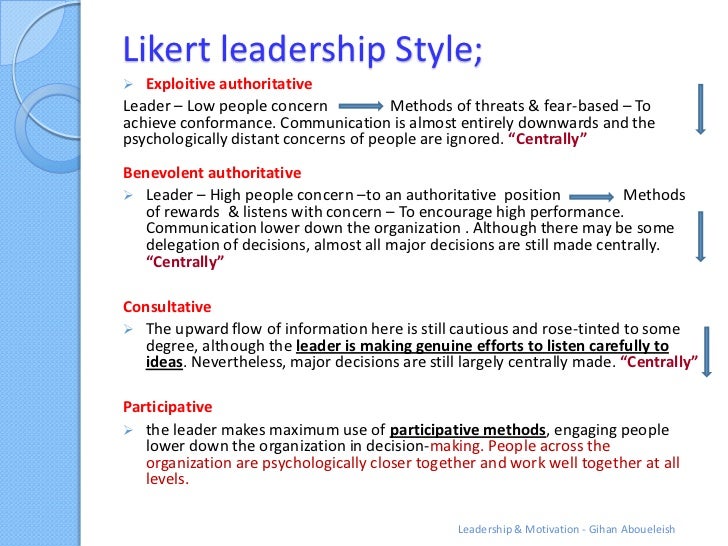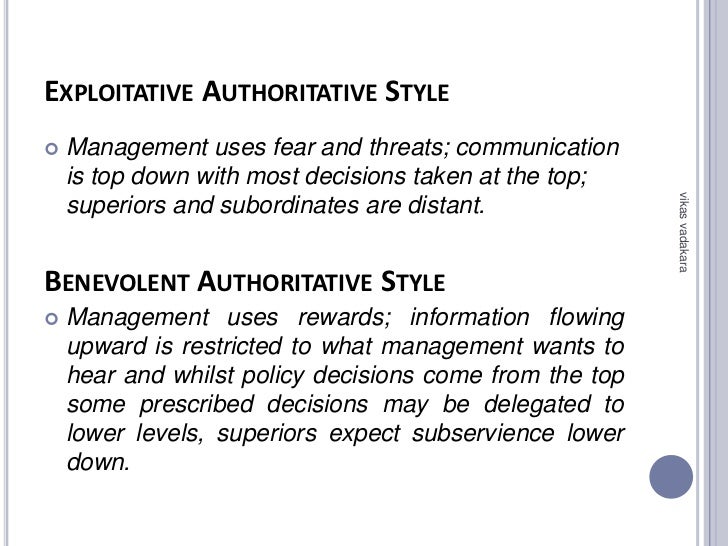Managerial grid, 1964, robert blake and jane mouton. He outlined four systems of management to describe the relationship, involvement, and roles of managers and subordinates in industrial settings.
there live to ready Advantages Of Autocratic Leadership Style
Subordinates feel no freedom to discuss things about the job with their superior.

Exploitative authoritative leadership style. With these four systems of management, likert studied seven variables viz. In solving job problems, manager seldom gets ideas and opinions of subordinates. And how a leader communicates.
These systems indicate the stages of evolution of patterns of management in. Employees minds and muscles are used, 4. Whereas management styles can be categorised into four styles.
With full control over his team, leaving low autonomy within the group. The main difference between an authoritative and an authoritarian leader is that once authoritative leaders show employees how to complete tasks, they let them continue on their own. An authoritarian leadership style occurs when a leader controls and directs all activities, dictates procedures and policies, and decides what objectives are to be achieved without any meaningful participation by his subordinates.
Thus, authoritarian leaders possesses authority over their subordinates which further induces employee compliance and submission. Exploitative authoritative, benevolent authoritative, consultative, and. At its heart, authoritative leadership depends on a thoroughly developed sense of emotional intelligence.
They make decisions and communicate them downward to subordinates. There are three main aspects in leadership styles. In 1939, psychologist kurt lewin defined the authoritative leadership style and described its benefits and limitations.
The model was developed on the basis of a questionnaire administered to managers in over 200 organizations and research into the performance characteristics of different types of organizations. He or she makes all the decisions about what, where, when, why, how things are done. The dark or destructive side of leadership behavior has attracted the attention of many scholars and practitioners in recent years (liao and liu 2016).much of the research has focused on authoritarian leadership (e.g., chan et al.
Five styles of leadership, i.e. He characterized the authoritative or autocratic leader as one who exerts absolute control in guiding a company and making decisions. They offer direction, guidance, and feedback to maintain enthusiasm and a sense of accomplishment throughout a project or endeavor.
To be effective, authoritative leaders must demonstrate certain. Exploitative authoritative, benevolent authoritative, consultative system and participative system. How authority is used, 2.
The above management styles are also often referred to as: Subordinates might characterize the methods of. They were developed by rensis likert after an analysis of 200 organizations in the 1960s.
The four systems of management system or the four leadership styles identified by likert are: The managerial grid is the tool designed by blake and mouton to determine the leadership style. How a leader relates to others, 3.
08/22/2015 / in careers / by joseph chris. Likert's management systems are management styles developed by rensis likert in the 1960s. Such a leader has full control of the team, leaving low autonomy within the group.the group is expected to complete the tasks under very close.
Likert’s management systems are a series of leadership theories based on the study of various organizational dynamics and characteristics. System 3 (consultative), system 4 (participative group or democratic). These leaders prefer to make choices that are based on their own experiences, judgments, and ideas.
They are exploitive authoritative, benevolent authoritative, consultative and participative styles (mullins, 2005).there were two major styles of. In the exploitative authoritative system, leaders have a low concern for people and use methods such as. It is a style that is characterized by personal control over all decisions that must be made for a team.
Leadership styles can be identified by. For a detailed description of these systems click on the link below: Leaders using this style rarely take input from their team members when making decisions.
The four styles were developed with a lot of research and observation. It is characterized by a lack of employee empowerment, trust, or confidence. Likert proposed four management systems:
The authoritarian leadership style is focused solely on the leader. The likert’s management system consisted of four styles and they are exploitative authoritative, benevolent authoritative, consultative and participative. Subordinates are not involved in decision making.
Doing so sparks innovation and new ideas for accomplishing daily tasks. Exploitative authoritative systems are extremely hierarchical, with power and responsibility lying at higher levels within the organisation. Likert’s four systems of management;
The leader or manager using this style operates like a dictator. Likert’s four styles of leadership. An authoritarian leadership style is exemplified when a leader dictates policies and procedures, decides what goals are to be achieved, and directs and controls all activities without any meaningful participation by the subordinates.

Rensis Likert Participative Management Management Pocketbooks



